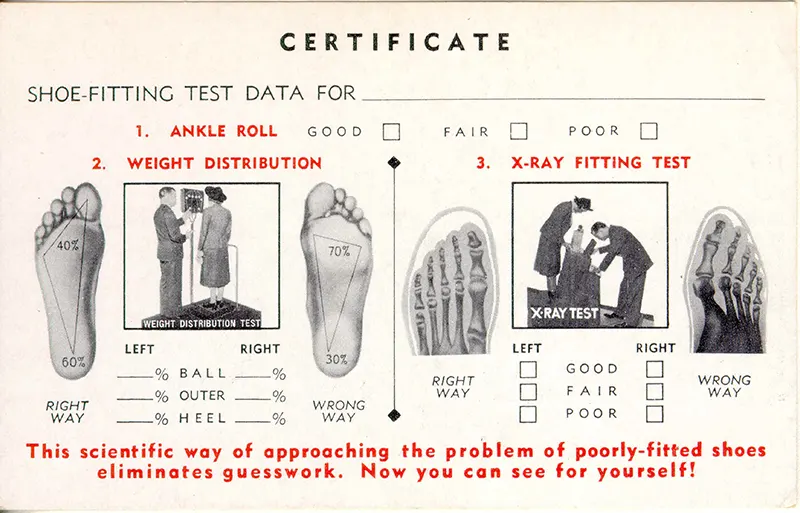People over age 65 are likely to remember this item from shopping for shoes with their mothers. The shoe-fitting fluoroscope was introduced to shoe stores in the 1920s and were manufactured in the United States until the mid-1950s. Paul Frame, Ph.D., a health physicist and trainer at ORAU and curator of the ORAU Museum of Radiation and Radioactivity, added this fascinating item to the collection due to the X-ray tube that was used inside the equipment. Here are four things to know about the shoe-fitting fluoroscope:
1. How it works

If you were not around during the popular days of the shoe-fitting fluoroscope, the process was quite simple. A typical unit consisted of a vertical wooden cabinet with an opening near the bottom. The child would step up on the platform in the shoes they were trying on, and they would stick their feet inside the machine. At the top of the shoe-fitting fluoroscope, there were three viewing ports. On one end, there was a place where the child could look, and on the opposite end a viewing port for both the salesman and the child’s parent. Through the viewing port, a fluorescent image of the bones of the child’s feet and the outline of the shoe could be seen. The parent and salesman could see how the shoe fit to determine the correct shoe size to purchase.
2. Who invented it
Now that you know a little more about the shoe-fitting fluoroscope, let’s discuss the mastermind behind it. This topic is not without its controversy. In fact, there are a few individuals who have laid their claim to fame for the item. According to the book, “Baring the Sole: The Rise and Fall of the Shoe-fitting Fluoroscope,” Dr. Jacob Lowe has the strongest claim. The book states that Lowe created the first fluoroscopic device for X-raying feet during WWI. By eliminating the need for patients to remove their boots, the device sped up processing for injured military members who were in need. There is another tale that Matthew B. Adrian was the inventor. According to his write-up in the “National Cyclopedia of American Biology,” Adrian obtained a patent for the first X-ray machine used for fitting shoes in 1917. Finally, there is a story that a man named Clarence Karrer built the first shoe-fitting fluoroscope while working with his father in 1924.
3. Radiation exposure
When children put their foot into the machine, they were effectively standing on top of the X-ray tube. According to experts, the machines generally employed a 50 kilovolt X-ray tube operating at 3 to 8 milliamps. The only shielding between your feet and the tube was a one millimeter thick aluminum filter. Some of the units allowed the operator to select one of three levels of intensity. There was also a push-button timer that allowed the salesman to set a desired exposure time, but most machines were set for 20 seconds.

4. Backlash and legislative response
In 1946, the American Standards Association established a “safe standard of tolerance dose” that stated that the feet receive no more than 2 roentgen per 5-second exposure. In addition, children were not to receive more than 12 such exposures in a single year. As a result of this measure, manufacturers became concerned that their products would have to meet a myriad of standards that could vary from state to state. By the early 1950s, several professional organizations had issued warnings about the continued use of shoe-fitting fluoroscopes. By 1960 these events, plus pressure from insurance companies, led to the demise of the machine in the United States. Despite the exposure rate, there were no reported injuries to shoe store customers, likely due to the limited amount of time they were on the machine. However, there was greater concern for the manufacturers of the shoe-fitting fluoroscope. There were also a couple of injuries reported among shoe saleswomen, including dermatitis over time from using the machine and one major radiation burn that led to the amputation of the employee’s leg.
Would you like to learn more about some of the consumer items located in ORAU’s Museum of Radiation and Radioactivity? Be sure to check out the virtual tour of the museum to get an inside look!